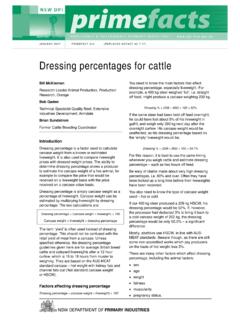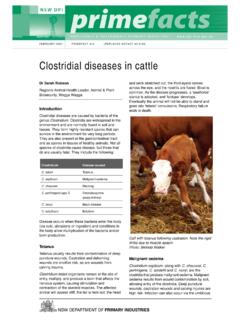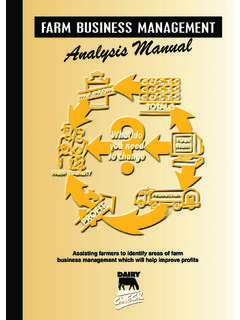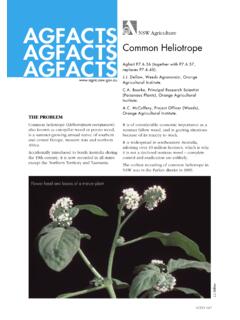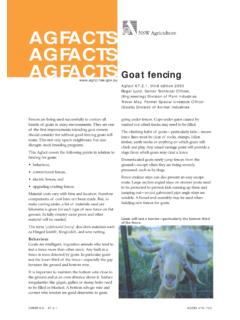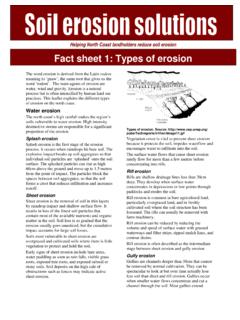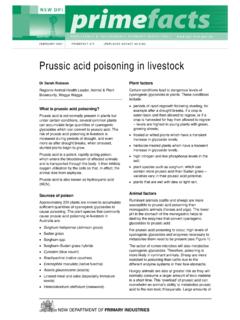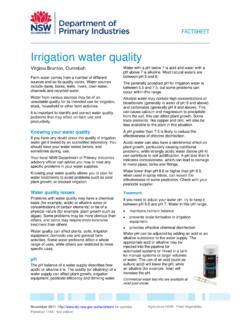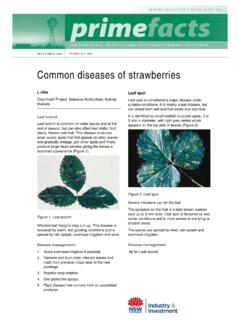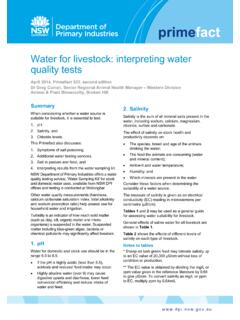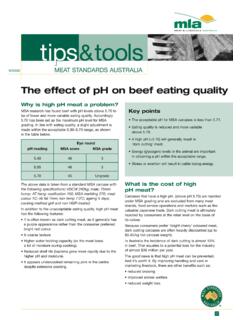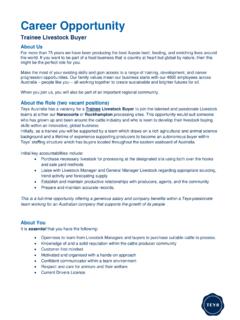Transcription of Cattle breed types - Department of Primary Industries
1 MAY 2007 PRIMEfACT 623 Cattle breed types Brian Cumming Livestock Officer ( beef Products), Albury There are far more breeds of Cattle in the world than are available in Australia, although close to 100 are represented in Australian herds. Many of these breeds have similar biological properties. Some are more popular than others and are used in larger numbers. Often many of the Cattle in these popular breeds have BREEDPLAN genetic estimates; this gives producers more confidence to use the breed . The environment in which the Cattle are run and the market that will be supplied by their progeny should be used to determine the most appropriate breed types to use. In many cases a single breed will be appropriate. This breed should be selected as an all-round performer in many traits. Crossbreeding within the herd can make better use of breed selection by combining breeds with different strengths to produce a final sale progeny that the market wants.
2 These progeny will also have hybrid vigour to lift their performance even more. All breeds are slightly different, but many are similar in terms of some of the important traits. for this reason it is often more useful to select the right breed group of Cattle for your breeding system and then select the breeds you prefer from within that group. Table 1 (on the next page) is a list of breed groups. Different breeds are listed in each group; breeds in the same group have similar biological performance. British breeds are generally earlier maturing and are thus able to fatten on less feed. for this reason they perform well on moderate nutrition and are popular in many parts of the country. They have high fertility and good eating quality. Some British breeds are used in the industry as high-marbling breeds and are suited to the Japanese feedlot market. British breeds and crosses of British breeds excel in maternal traits and make excellent mothers.
3 European breeds generally grow faster and have more muscle. They are generally later maturing than British breeds and need more feed to lay Select the right breed group and then choose the breed you prefer. Photo: Brian Cumming Table 1. breed group definitions BRITISH Angus, Hereford, Poll Hereford, Shorthorn, Galloway, Murray Grey, Devon Large British South Devon EUROPEAN Dual purpose Meat large mature size Simmental, Gelbvieh, Maine Anjou, Brown Swiss Charolais, Romagnola, Chianina Meat medium mature size Limousin, Blonde Aquitaine Double-muscled Belgian Blue, Piedmontese BOS INDICUS Brahman, Sahiwal ADAPTED TAURINE / Tuli, Senepol SANGA DAIRY Holstein, Jersey JAPANESE Black Wagyu, Red Wagyu COMPOSITE Santa Gertrudis, Santa Gertrudis, Braford, Bos indicus composite Brangus, Droughtmaster, Charbray, Belmont Red down fat cover. Many successful crossbreeding herds cross European bulls over British breed cows to produce faster growing, higher yielding calves.
4 Some European breeds are also strong in maternal traits and make excellent mothers. Bos indicus breeds are usually run in parts of the country with poorer nutrition. They have higher survivability, adaptation to poorer environments and greater parasite resistance. Bos indicus and Bos indicus British cows are often used in coastal environments and in northern Australia. Breeds used in the dairy industry are high milk producers that can differ in body size and maturity pattern. Often dairy breeds are combined with British breeds to produce specialist vealer-producing cows. They need good nutrition to perform well. Composite breeds can be a combination of two or more breeds. The breeds used to set up the composite will determine the biological type of the animals and how it will perform under different nutritional conditions. There can be as many composite types as breed types , so it is not appropriate to compare one composite with another unless the parent breeds are known or the biological type is considered.
5 Most common breeds used in Australia were originally developed as composites of other breeds. The selection of appropriate breeds to use in a breeding plan is the first step. On average, the most appropriate breed will perform the best. However, breed is not a guarantee of performance, and it is equally important to select the most appropriate sires within each breed to breed future herd females and sale progeny. Using BREEDPLAN genetic estimates and combining these with appropriate visual selection will lessen the risk of having poor performers. The breeds used in a composite will determine the biological type of the composite and how it will perform. Photo: Brian Cumming PRIMEfACT 623, Cattle breed types Further reading Primefact 249 Checking your bull is ready for joining Primefact 620 Developing an effective breeding plan for your beef business Primefact 621 Market specifications for beef Cattle Primefact 622 Live beef Cattle assessment Primefact 624 beef Cattle breeding systems Primefact 625 Using EBVs and $ Index Values in beef breeding Primefact 626 Selecting and managing beef heifers Primefact 627 Economic advantages of better management of your beef breeding herd Further information for further information contact your local NSW Department of Primary Industries Livestock Office ( beef Products).
6 State of New South Wales through NSW Department of Primary Industries 2007. You may copy, distribute and otherwise freely deal with this publication for any purpose, provided that you attribute NSW Department of Primary Industries as the owner. ISSN 1832-6668 Check for updates of this Primefact at Disclaimer: The information contained in this publication is based on knowledge and understanding at the time of writing (May 2007). However, because of advances in knowledge, users are reminded of the need to ensure that information upon which they rely is up to date and to check currency of the information with the appropriate officer of New South Wales Department of Primary Industries or the user s independent adviser. Job number 7822 PRIMEfACT 623, Cattle breed types
